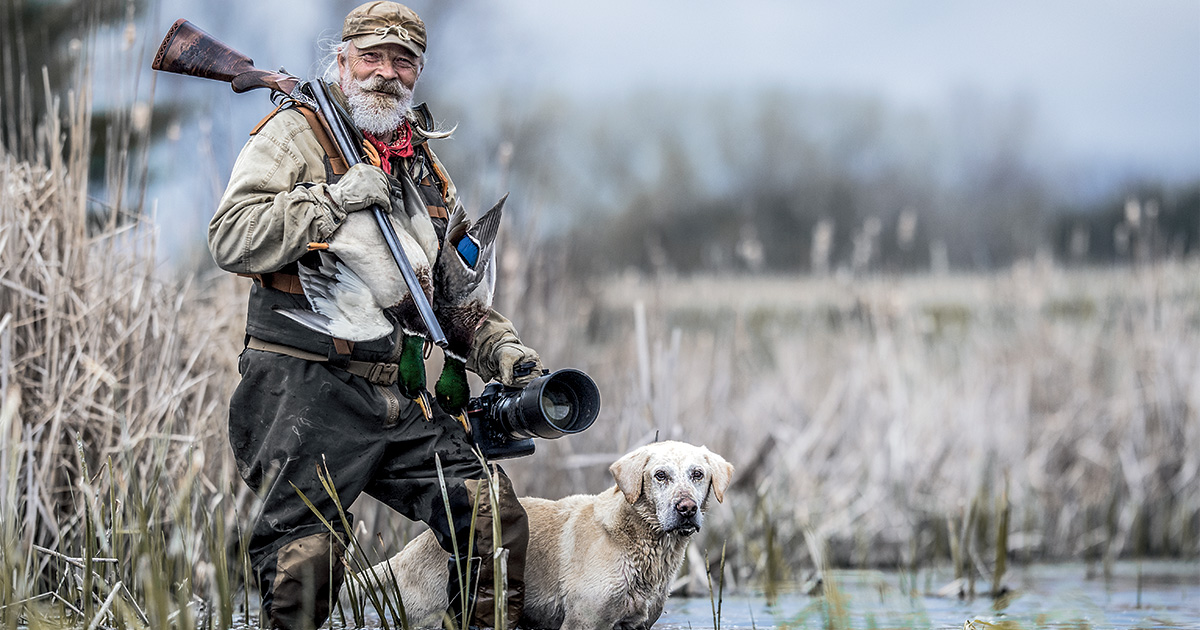Waterfowler's World: Portrait of an Artist
Known for his cutting-edge digital photography, Lee Kjos remains an old-school waterfowler at heart
Known for his cutting-edge digital photography, Lee Kjos remains an old-school waterfowler at heart

By Bill Buckley

Anyone who has ever leafed through a copy of Ducks Unlimited has likely seen Lee Kjos's work. In fact, his images have graced the cover of this magazine more than any other photographer. His unique portrayal of retrievers in action and waterfowlers braving the elements has also made him one of the most sought-after commercial photographers in the outdoor industry.
While Kjos's expertise with digital photography and the latest post-production techniques has enabled him to develop his distinctive look, in every other respect he is a man from a different era. He pines for the no-nonsense hunting culture of yesteryear and is obsessed with traditional gear and tactics. At the center of it all is a love of ducks.
"I grew up in a small hunting and fishing camp in Big Fork, Minnesota," Kjos says. "Dad was already a big supporter of DU and habitat conservation when I was born in 1960. That's where I got my love for all things wild, particularly ducks. I've always had a huge desire to give back to the ducks."
Ducks were Kjos's main motivation for picking up a camera. When he was eight or nine, he took his father's Minolta camera with a 35mm lens to a nearby slough. "A greenwing drake skidded in about 15 feet away. I dialed in, took the picture, and bugged my parents later to get the film developed. I still remember pulling out the photograph. Of course, you could barely see the duck," he says, laughing. "I was crushed!"
But that only motivated Kjos to keep at it. At age 14, he got a summer job detasseling corn and invested his entire earnings in his first professional camera, a Nikon FM. Cutting and selling firewood got him an inexpensive 500mm mirror lens his parents had put on layaway. "Honestly, I never took a good picture with it," he recalls. "But that's what makes you want to get better."
Captivated by art at an early age, Kjos learned to paint and draw as well as take photographs. That led to an early career as a medical illustrator and graphic designer, where he learned to use software to edit photographs and illustrations. "When I figured out how to rasterize a vector file I'd drawn, it was life changing," he says. "I became an expert in digital branding by default, not because I was that good at it yet, but because nobody else was doing it."
Kjos's post-production skills enabled him to take already gritty images of waterfowlers and replace bland, overcast skies with dramatic weather conditions, add flights of ducks and geese to the background, and overlay textures like canvas to give his photos a timeless quality. It quickly became his look and attracted companies seeking new ways to connect with their customers.
"I'm hired to tell stories," Kjos says, "to inspire hunters to go out and hopefully have the same experiences that I've had while hunting divers on the big lakes of northern Minnesota and ducks and geese on the Canadian prairies. My dad and the Creator are my biggest sources of inspiration. I've seen some amazing things in nature. But I also love the old sporting artists: Lynn Bogue Hunt, Philip Goodwin, Francis Lee Jaques, Richard Bishop, Frank Benson, and Chet Reneson."
To say Kjos is old school isn't an exaggeration. "I am a hopeless romantic. My life is rooted in the traditions and history of waterfowling. I love old wooden duck calls and handmade decoys. I don't wear camo. I shoot a Winchester Model 21 side-by-side, and if the ducks aren't close and finished, I don't shoot. That's just who I am. It's all about how and who I'm with now, not how many."
When asked what he would like his legacy to be, Kjos is pretty clear. "I want hunters to start thinking about themselves and where they fit into conservation and habitat. If that's not at the forefront, then I didn't do my job. Get involved and stay involved and help change the narrative."
Ducks Unlimited uses cookies to enhance your browsing experience, optimize site functionality, analyze traffic, and deliver personalized advertising through third parties. By continuing to use this site, you agree to our use of cookies. View Privacy Policy